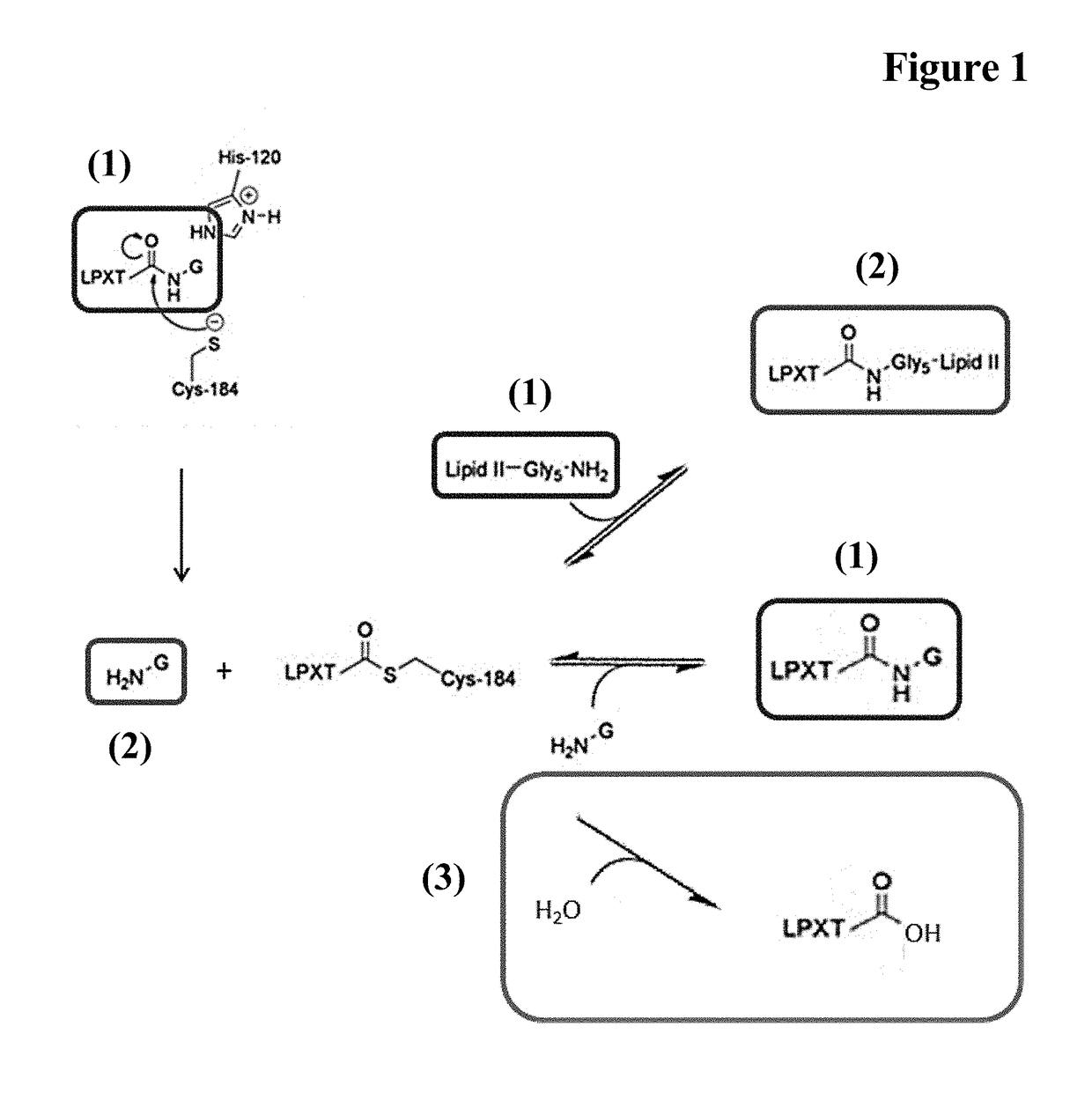Methods for enzyme mediated polypeptide conjugation
a polypeptide and enzyme technology, applied in the field of enzyme-mediated polypeptide conjugation, can solve the problems of lpxt product, and achieve the effect of increasing the yield
- Summary
- Abstract
- Description
- Claims
- Application Information
AI Technical Summary
Benefits of technology
Problems solved by technology
Method used
Image
Examples
example 1
Generation of an Expression Plasmid for Soluble S. aureus Sortase A
[0127]The sortase gene encodes an N-terminally truncated Sortase A (60-206) molecule (amino acid sequence of SEQ ID NO: 21).
[0128]The expression plasmid for the transient expression of soluble Sortase in HEK293 cells comprised besides the soluble Sortase expression cassette an origin of replication from the vector pUC18, which allows replication of this plasmid in E. coli, and a beta-lactamase gene which confers ampicillin resistance in E. coli.
[0129]The transcription unit of the soluble Sortase comprised the following functional elements:[0130]the immediate early enhancer and promoter from the human cytomegalovirus (P-CMV) including intron A,[0131]a human heavy chain immunoglobulin 5′-untranslated region (5′UTR),[0132]a murine immunoglobulin heavy chain signal sequence,[0133]a purification tag encoding nucleic acid,[0134]an N-terminally truncated S. aureus Sortase A encoding nucleic acid, and[0135]the bovine growth...
example 2
Transient Expression and Analytical Characterization
[0139]The recombinant production was performed by transient transfection of HEK293 cells (human embryonic kidney cell line 293-derived) cultivated in F17 Medium (Invitrogen Corp.). For transfection “293-Fectin” Transfection Reagent (Invitrogen) was used. Transfection was performed as specified in the manufacturer's instructions. Cell culture supernatants were harvested three to seven (3-7) days after transfection. Supernatants were stored at reduced temperature (e.g. −80° C.).
[0140]General information regarding the recombinant expression of human immunoglobulins in e.g. HEK293 cells is given in: Meissner, P. et al., Biotechnol. Bioeng. 75 (2001) 197-203.
[0141]The protein concentration was determined by measuring the optical density (OD) at 280 nm, using the molar extinction coefficient calculated on the basis of the amino acid sequence. Purity was analyzed by SDS-PAGE in the presence and absence of a reducing agent (5 mM 1,4-dithio...
example 3
Sortase Mediated Conjugation
[0142]A reaction mixture comprising 100 μM Fc-region fragment comprising a C-terminal LPETG Sortase motif (SEQ ID NO: 30), 100 μM Fc-region fragment containing an N-terminal triple-alanine motif (SEQ ID NO: 27) and 10 μM Staphylococcus aureus Sortase A in 50 mM Tris pH 7.5, 150 mM NaCl, 5 mM CaCl2 was incubated at 37° C. for 40 hours.
[0143]In the samples taken after 16 hours and 40 hours the reaction was stopped by heating to 90° C.
[0144]The samples (32.5 μl) supplemented with 5 μl reducing agent (Novex) and 12.5 μl sample buffer (Novex) were incubated for 10 min. at 90° C. 20 μl of each preparation were loaded on a 4-12% Bis-Tris gradient gel (Novex). The gel electrophoresis was carried out in 1×MOPS buffer (Novex) at 200 V and 120 mA for 35 min.
PUM
| Property | Measurement | Unit |
|---|---|---|
| pH | aaaaa | aaaaa |
| time | aaaaa | aaaaa |
| size | aaaaa | aaaaa |
Abstract
Description
Claims
Application Information
 Login to View More
Login to View More - R&D
- Intellectual Property
- Life Sciences
- Materials
- Tech Scout
- Unparalleled Data Quality
- Higher Quality Content
- 60% Fewer Hallucinations
Browse by: Latest US Patents, China's latest patents, Technical Efficacy Thesaurus, Application Domain, Technology Topic, Popular Technical Reports.
© 2025 PatSnap. All rights reserved.Legal|Privacy policy|Modern Slavery Act Transparency Statement|Sitemap|About US| Contact US: help@patsnap.com



